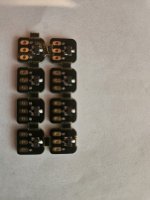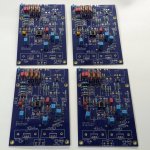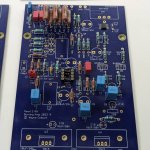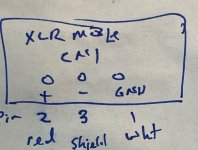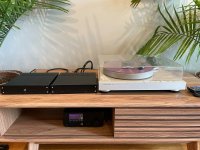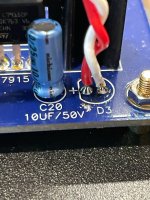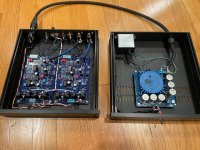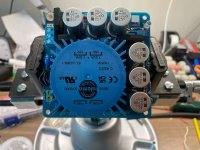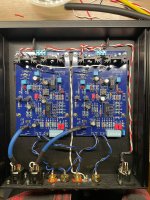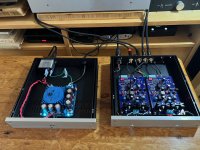Once I fixed the cascade bias, it seems to be perfect, but I haven’t put a signal analyzer or oscilloscope on it to see if there is an issue I cannot hear. It would be easy to remove one, however.
Quick newbie question related to the power supply board in this PCB set - is this easily modifiable for difference voltages?
I ask because I feel like a small power supply board/kit for PCB mount transformers could be a good addition to the store for those wanting to, for example, build an ACP+ with a linear supply in the one chassis. Or pretty much any light VA requirement project that normally uses a wall wart.
Sorry if I'm too far off topic, or of this has been asked before - I just saw the board while browsing the store and got curious. Feel free to direct me to a different thread or subforum if need be.
I ask because I feel like a small power supply board/kit for PCB mount transformers could be a good addition to the store for those wanting to, for example, build an ACP+ with a linear supply in the one chassis. Or pretty much any light VA requirement project that normally uses a wall wart.
Sorry if I'm too far off topic, or of this has been asked before - I just saw the board while browsing the store and got curious. Feel free to direct me to a different thread or subforum if need be.
DT, 6L6, others:
The 2SK209 GR JFets arrived today and they seem perfect for those of us that would like to avoid smd soldering. The three holes in each of the units make it simple indeed to affix to the same-width holes on the pcb -- just align the gate, source, and drain. Sent to you from Aion in 2 days for $16.80.
SO, thanks DT -- great help.
The 2SK209 GR JFets arrived today and they seem perfect for those of us that would like to avoid smd soldering. The three holes in each of the units make it simple indeed to affix to the same-width holes on the pcb -- just align the gate, source, and drain. Sent to you from Aion in 2 days for $16.80.
SO, thanks DT -- great help.
Attachments
twofires: I get dual rail PSUs from Randy Thatcher directly and they can be configured for a wide range of voltages. The kit psu might not be ideal because it does not have the final regulator. PM Randy and see what he says.
Thanks for that - I'll look into it!
The kit psu might not be ideal because it does not have the final regulator.
It is not so much about the kit.
It is about the idea or design, it is complete.
The transformer, bridge rectifier and CRCRC smoothing are remote. All the transformer fields and switching noise are 6 feet away. The final regulation of the quiet DC is isolated with the high gain circuitry.
Why would you want it any different?
Thanks DT
If we're talking about the ACP+, well, I have reasons, but, I'll keep them for a relevant thread. Apologies for the OT discussion.Why would you want it any different?
Build in progress. I chose larger Dales (RN65) for the MC load resistors.
First time I use an LCR meter (Victor 4091C). It makes matching components so easy. Since it is fanless, I leave it on all the time and match everything between left and right pcbs.
Boards and kits are very nice.
First time I use an LCR meter (Victor 4091C). It makes matching components so easy. Since it is fanless, I leave it on all the time and match everything between left and right pcbs.
Boards and kits are very nice.
Attachments
I made my own, smaller boards for adapting 2SK209s to 2SK170 footprints. 209s can be mounted on either side for versatility, and the boards are the same width as the TH devices. These can be mounted facing each other with the transistors in contact for thermal tracking. I've matched up a bunch of 209s for these.
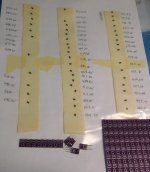
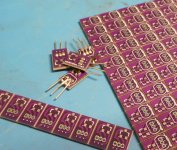


Listening to my newly-completed Pearl 3 as I write this. I'm not surprised that it sounds as good as it does, but to actually hear it is immensely gratifying. It's dead quiet, and presents a big, wide soundstage. Stage depth is very good too -- right off the bat I'm getting a really engaging sense of three-dimensional space (my system tends to image behind the speaker plane). I built this because I was anticipating upgrading my Goldring E3, and wanted the option to try out some low-output cartridges (e.g. the Grado Opus3/Platinum3/Sonata3 low-output). But with the Pearl 3, the E3 sounds just lovely, and I may just stop now while I'm ahead.
The build was straightfoward but moderately challenging, especially compared to building a pair of ACA monoblocks, and then an ACA Mini. It took me a good four days once I had accumulated all of the parts. On the other hand, besides having to fix the polarity of the power-indicator LEDs, this thing just came up and worked first try! Great testimony to the circuit and kit design, and the build guide.
Couple of notes that might help others:
The build was straightfoward but moderately challenging, especially compared to building a pair of ACA monoblocks, and then an ACA Mini. It took me a good four days once I had accumulated all of the parts. On the other hand, besides having to fix the polarity of the power-indicator LEDs, this thing just came up and worked first try! Great testimony to the circuit and kit design, and the build guide.
Couple of notes that might help others:
- The font-panel LED terminals on the audio board (D3) has a "+" next to the negative pad. The part outline is drawn correctly, and the "+" is actually associated with the adjacent capacitor (C20), but it tripped me up. Non-catastrophic, and easy to rework, but worth looking out for
- The balanced output connectors (CN1) aren't labeled, so I had to (gasp) squint at the circuit diagram to figure out how they're wired up. (It's V+/V-/Ground, or pin 2/3/1, FWIW).
- I had hoped to order a black anodized faceplate, but couldn't justify the one-off tooling costs. As it happens, I needed to powder coat some parts for another project, so I added these faceplates to the job. I like it much better flat black, but I also miss the "Pearl 3" lettering.
Attachments
@ekobi
Lovely work. A couple of questions:
Your diagram of the balanced connections seems off. Isn't the ground/shield on pin 1?
I was hoping you were running the Pearl through a balanced preamp (Wayne's BA2018 perhaps) into the balanced connector of the ACA monoblocks. Then I'd ask how your setup worked... and into what speakers?
I'm considering "balancing" my BA2018 and looking for a balanced amp to feed an Alpair 10.3M build -- either the FHXL or Pencil. The amp could be the ACA monos or an Aleph J.
Lovely work. A couple of questions:
Your diagram of the balanced connections seems off. Isn't the ground/shield on pin 1?
I was hoping you were running the Pearl through a balanced preamp (Wayne's BA2018 perhaps) into the balanced connector of the ACA monoblocks. Then I'd ask how your setup worked... and into what speakers?
I'm considering "balancing" my BA2018 and looking for a balanced amp to feed an Alpair 10.3M build -- either the FHXL or Pencil. The amp could be the ACA monos or an Aleph J.
Thanks @audiosteve . The T60 is nice, and randomly "gifted" to me: when a friend of mine moved to NZ for a few years, I bought his car from him, and discovered the turntable in the trunk, along with a few boxes of LPs!@ekobi Nice work. BTW, your's is the only other HK T60 turntable I have ever seen besides mine. It's a great piece of kit. What kind of cartridege are you using to feed your Pearl 3?
Currently fitted with a Goldring E3 to replace the Grado Black after the latter was destroyed by rambunctuous teens (allegedly!). How about yours?
Sounds good. I paid real money for mine but that was almost 40 years ago! I've never heard a Goldring. I use a Nagaoka MP-110. It is remarkably good for its price. I am looking forward to hearing it with my Pearl 3. I am waiting for power supply parts right now so I can finish it.
Thank you!Lovely work. A couple of questions:
Your diagram of the balanced connections seems off. Isn't the ground/shield on pin 1?
I was hoping you were running the Pearl through a balanced preamp (Wayne's BA2018 perhaps) into the balanced connector of the ACA monoblocks. Then I'd ask how your setup worked... and into what speakers?
I'm considering "balancing" my BA2018 and looking for a balanced amp to feed an Alpair 10.3M build -- either the FHXL or Pencil. The amp could be the ACA monos or an Aleph J.
Good catch on the pinout diagram! Fortunately, I haven't tried the balanced output yet, and I'll review what I did when I get home. I'll pull the diagram until verified.
My preamp is a Benchmark HPA4, which is driving the ACA monoblocks, into a pair of Spatial Audio X4s (from 2022, not the Ultra variants). The Benchmark is astonishing. For a while, I was running my DAC directly into the ACA monoblocks, and using its built-in attenuator for volume control. As expected the HPA4 was a tonally neutral addition to the signal chain, but the increase in resolution blew me away. I think it's the relay gain control that's shining here, but whatever they're doing, it's kind of neat.
The Alpair speakers are new to me. Looking forward to investigating.
Lovely. VERY tidy work - compulsion at its best.Build in progress. I chose larger Dales (RN65) for the MC load resistors.
First time I use an LCR meter (Victor 4091C). It makes matching components so easy. Since it is fanless, I leave it on all the time and match everything between left and right pcbs.
Boards and kits are very nice.
Your RN65's give the PCB's a sort of architectural appeal ;-)
This kind of susceptibility in my experience is usually caused by insufficient stability margin. The circuit doesn't oscillates but has a huge HF peak in the frequency response. As a result, it produces HF burst when triggered by sharp edged signal.My Pearl 3 sounds great, however it's susceptible to static electricity via the turntable and spikes in the AC power network. When I switch on the power of my CD player, I hear a thump through my speakers when phono is selected on the preamp (not when I select another source). Could this be linked to the ground/earth of the Pearl 3? Wiring is according to build guide.
How much gain is set?
This kind of susceptibility in my experience is usually caused by insufficient stability margin. The circuit doesn't oscillates but has a huge HF peak in the frequency response. As a result, it produces HF burst when triggered by sharp edged signal.
An interesting observation. True IF you eliminate the RIAA compensation network reactive elements.
You can demonstrate in LTSpice by breaking the feedback loop and inserting a small AC signal with an injection transformer into the FB loop. Easy in real time if you have a vector network analyser.
Shouldn't be the problem in real life with the RIAA compensation network reactive components installed.
- Home
- Amplifiers
- Pass Labs
- Pearl 3 Burning Amp 2023
